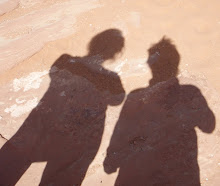And then Chelsea had a great opportunity to go see some of the recent flooding in the Murray-Darling Basin and meet with some local people working on various aspects of water management. So I found myself up at 4 AM in the morning, having packed two big bags of cycling gear (for Melbourne) and hiking gear (for the Top End) as well as two bicycles into bike boxes (from our friendly local bike shop) the previous night. I got the boxes and the bags to the rail terminal, checked in, found a seat on the train, and went straight to sleep. It took a courier truck and a taxi to get me and all of the luggage to the train depot – apparently there are no taxis large enough for bike boxes, and courier services refuse to carry human beings. Oi.
Arriving at Melbourne’s Southern Cross station in the evening, I was met by Geoff Dale (thankfully, because I wasn’t sure how I was going to manage two bike boxes and 30 kilos of other luggage). After a brief day with the Dales, we caught our flight from Melbourne to Darwin. (That’s another story.) After ten days up in the Top End, we returned to Melbourne and the start of Worlds.
Anyway, 2010 was one of the few times that Worlds has been held outside of Europe and the first time they have traveled to the southern hemisphere. The previous year, when Mendrisio, Switzerland hosted Worlds, Cadel Evans had become the first Australian to win the rainbow jersey of world champion. So it was that all of Australia was brimming with pride to have Worlds on their soil. Or at least they were brimming with pride until the week before Worlds, when the AFL Grand Final (sort of the Australian equivalent to the Super Bowl) ended in a tie. Because the rules don’t provide any sort of tie-breaking mechanism, the teams were left with nothing to do except play a repeat game the following weekend. Right during Worlds. That was okay with us, because it meant less people at the race venue, but it was a blow to the race organizers. The Grand Final replay was on Saturday, which was particularly hard for the women’s road race on that day. Women’s cycling gets the shaft enough as it is, so it seemed a bit unfair to the riders that day. Nevertheless, the attendance at the men’s road race on Sunday was in excess of 150,000, significantly more than the 90,000-odd spectators at the Grand Final replay, a good sign for the health of cycling in Australia.
Things kicked off with the time trials on Wednesday and Thursday. Taylor Phinney (“mini-Phinney” and also from Chelsea’s hometown of Boulder, CO) represented the United States admirably, winning the U-23 time trial by a fraction of a second. I guess it helps to be the son of two Olympic gold medalists in cycling. Emma Pooley of Britain capped off a great season by winning the women’s TT, and Fabian Cancellara won the men’s title for the fourth time in his career. The men’s TT was a great event, with Tony Martin coming in third despite having to change a wheel and David Millar putting in a huge effort to grab the silver. Cancellara was hugely impressive – he rode the entire race strongly and in control, making it look easy as he finished about a minute ahead of Millar.
Cyclists celebrate events like the Tour de France or Worlds by going out and riding. Almost every day that we were in Melbourne we rode. Sometimes it was just Chelsea and I, sometimes we rode with Geoff, and on occasion I rode in a small group with Geoff and some other riders. We rode on the local Boulevard, the Melbourne institution of Beach Road, and climbed up into the Dandenongs. We also ate well and frequently, a great part of being at the Dales’ house. Cycling does give one an appetite, and between all of the meals and snacks and afternoon cappuccinos, it is a miracle that I didn’t gain 5 kilos. Maybe Geoff was trying to slow me down for the climbs.
On Friday, we headed down to Geelong for the whole day to watch the men’s U-23 road race. It was a good race to watch, with Ben King (USA) going solo off the front for most of the race. Eventually, despite the two steep climbs on the looped course, the race came down to a sprint and Michael "Bling" Matthews won. The Aussies went crazy for their hometown boy getting the gold medal. Taylor Phinney showed well again, actually tying in a photo finish with an Italian for third. Phinney is going to BMC next year, and it looks like he’ll have a great career ahead of him.
